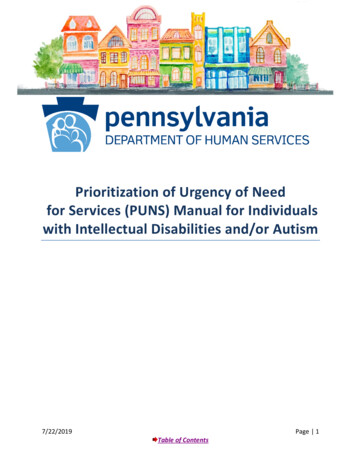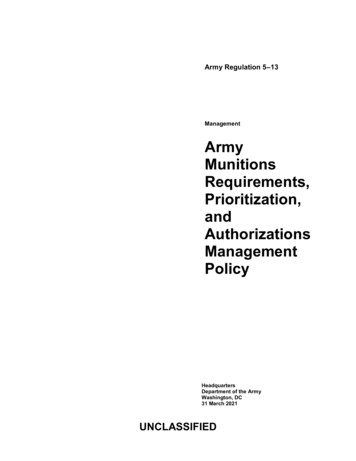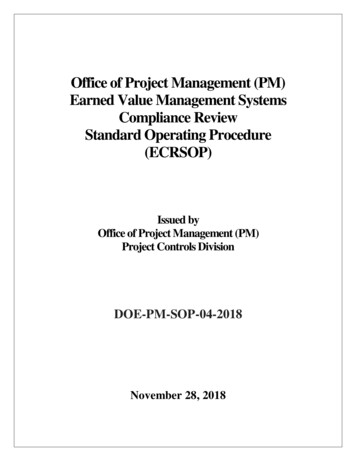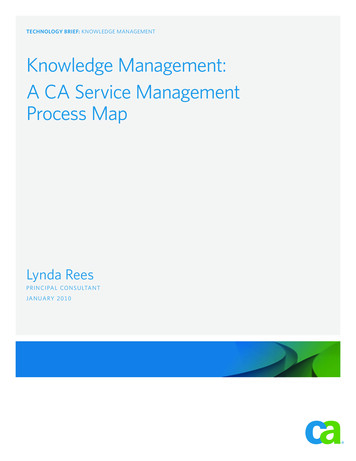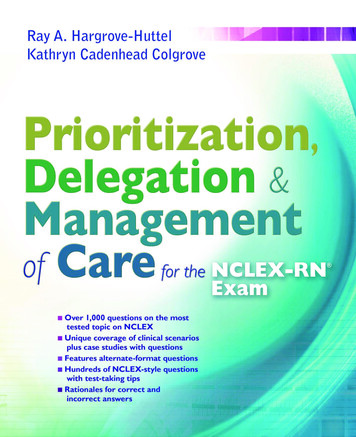
Transcription
3313 FM i-xii 14/03/14 5:13 PM Page iPrioritization,Delegation, &Managementof Care for theNCLEX-RN Exam
3313 FM i-xii 14/03/14 5:13 PM Page iiDavis’s Success SeriesQ&A Course Review and NCLEX Prep99Thousands of NCLEX-style questions99Alternate-item-format questions99Rationales for correct and incorrect answers99Test-taking tipsVisit www.fadavis.comKeyword: Success Series to learn more.Davis Mobile APPSDownload today from yourfavorite app store!www.FADavis.com
3313 FM i-xii 14/03/14 5:13 PM Page iiiPrioritization,Delegation, &Managementof Care for theNCLEX-RN ExamRay A. Hargrove-Huttel, RN, PhDKathryn Cadenhead Colgrove, RN, MS, CNS
3313 FM i-xii 14/03/14 5:13 PM Page ivF. A. Davis Company1915 Arch StreetPhiladelphia, PA 19103www.fadavis.comCopyright 2014 by F. A. Davis CompanyCopyright 2014 by F. A. Davis Company. All rights reserved. This book is protected by copyright.No part of it may be reproduced, stored in a retrieval system, or transmitted in any form or by anymeans, electronic, mechanical, photocopying, recording, or otherwise, without written permission fromthe publisher.Printed in the United States of AmericaLast digit indicates print number: 10 9 8 7 6 5 4 3 2 1Publisher, Nursing: Robert G. MartoneDirector of Content Development: Darlene D. PedersenProject Editor: Jacalyn C. ClayElectronic Project Editor: Sandra A. GlennieIllustration and Design Manager: Carolyn O’BrienAs new scientific information becomes available through basic and clinical research, recommendedtreatments and drug therapies undergo changes. The author(s) and publisher have done everythingpossible to make this book accurate, up to date, and in accord with accepted standards at the time ofpublication. The author(s), editors, and publisher are not responsible for errors or omissions or forconsequences from application of the book, and make no warranty, expressed or implied, in regardto the contents of the book. Any practice described in this book should be applied by the reader inaccordance with professional standards of care used in regard to the unique circumstances that mayapply in each situation. The reader is advised always to check product information (package inserts)for changes and new information regarding dose and contraindications before administering any drug.Caution is especially urged when using new or infrequently ordered drugs.Library of Congress Cataloging-in-Publication DataLibrary of Congress Cataloging-in-Publication DataISBN: 978-0-8036-3313-1Authorization to photocopy items for internal or personal use, or the internal or personal use of specificclients, is granted by F. A. Davis Company for users registered with the Copyright Clearance Center(CCC) Transactional Reporting Service, provided that the fee of .25 per copy is paid directly toCCC, 222 Rosewood Drive, Danvers, MA 01923. For those organizations that have been granted aphotocopy license by CCC, a separate system of payment has been arranged. The fee code for users ofthe Transactional Reporting Service is: 978-0-8036-3313-1/14 0 .25.
3313 FM i-xii 14/03/14 5:13 PM Page vThank you to all the nursing students, nursing faculty, and nursing colleagues wehave had the privilege to work with during our careers. We want to thank RobertMartone for his vision and support, who was there when our writing career startedand has been with us every step of the way. Our thanks to computer extraordinaireGlada Norris, who fixes our mistakes, makes the questions look “pretty,” and isresponsible for making this book possible. Thank you to Kathryn McAfee who codesall the questions, leaving us time to write the questions.I want to thank all my friends for love, support, and prayers as I battled ovariancancer this last year. Thanks to aunts, uncles, and cousins, my Los Angeles friends,my Trinity Valley Community College friends, my Texas friends, my Hawaiianfriends, and the Lee girls. My thanks to my sisters Gail and Debbie, my nephewBen, and Paula who brought me home and cared for me. I thank my childrenTeresa and Aaron for making me want to get up every day and fight the fight.As always, I dedicate this book to my parents, T/Sgt Leo R. Hargrove and Nancy,who made me believe I can do anything. I am an ovarian cancer survivor.—R AY A. H ARGROVE -H UTTEL(This was Ray’s dedication. Ray lost her battle with cancer on December 23,2012. She is much loved and greatly missed. -Kathy Colgrove)I would like to dedicate this book to the memory of my mother, Mary Cadenhead,and grandmother, Elsie Rogers. They always told me I could accomplish anythingI wanted to accomplish. I would also like to dedicate this book to my husband, Larry,children, Laurie and Todd and Larry Jr. and Mai, and grandchildren, Chris,Ashley, Justin C., Justin A., Connor, Sawyer, and Carson—without their supportand patience the book would not have been possible.—K ATHRYN C ADENHEAD C OLGROVEv
3313 FM i-xii 14/03/14 5:13 PM Page vi
3313 FM i-xii 14/03/14 5:13 PM Page viiReviewersDebra Bailey, RN, PhD candidate, FNP, CDEAssociate Professor of Nursing, DepartmentHead Health SciencesColorado Mesa UniversityGrand Junction, ColoradoPatricia A. Bicknell, EdD, APRN,ACNS-BC, CNLAssistant Professor of Nursing; Track Coordinatorfor Clinical Nurse Leader (CNL)La Salle UniversityPhiladelphia, PennsylvaniaDonna Bowles, EdD, MSN, CNEAssociate ProfessorIndiana University SoutheastNew Albany, IndianaDiane Cohen, RN, MSNProfessorMassBay Community CollegeFramingham, MassachusettsDiane L. Cooper-McLean, RN, BSN, MSNNursing InstructorFaulkner State Community CollegeBay Minette, AlabamaPamela DeWitt, RN, MN, CNEResidential FacultyPhoenix CollegeDepartment of NursingPhoenix, ArizonaKathleen Walsh Free, MSN, RN-C, APRN-BCClinical ProfessorIndiana University SoutheastNew Albany, IndianaMaria McCormick, MSN, MS, RNFacultySpencerian CollegeLouisville, KentuckyMary Ann Siciliano McLaughlin, MSN, RNFaculty, UMDNJ School of NursingUMDNJ School of NursingStratford, New JerseyElizabeth Murray, PhD, RN, CNEAssistant ProfessorFlorida Gulf Coast University School ofNursingFort Myers, FloridaL. Jane Rosati, EdD, MSN, RN-BCAssistant Chair/Program Manager of theADN ProgramDaytona State CollegeDaytona Beach, FloridaFaye Sigman, PhDProfessor of NursingDyersburg StateDyersburg, TennesseeThomas Worms, RN, MSNProfessor of NursingTruman CollegeChicago, IllinoisPolly Gerber Zimmermann, RN, MS, MBA,CEN, FAENAssociate ProfessorHarry S Truman CollegeChicago, IllinoisLynn D. Kennedy, MSN, RNAssistant Professor of NursingFrancis Marion UniversityFlorence, South Carolinavii
3313 FM i-xii 14/03/14 5:13 PM Page viii
3313 FM i-xii 14/03/14 5:13 PM Page ixTable of Contents1Introduction to Prioritization, Assignment,Delegation, and ManagementNCSBN BLUEPRINT FOR QUESTIONSGUIDELINES FOR MAKING A DECISIONTYPES OF QUESTIONSPUTTING THE PIECES TOGETHER2Cardiovascular Management3Peripheral Vascular Management4Respiratory Management5Gastrointestinal Management6Renal and Genitourinary ManagementQUESTIONSCARDIAC CLINICAL SCENARIOANSWERS AND RATIONALESCLINICAL SCENARIO ANSWERS AND RATIONALESQUESTIONSPERIPHERAL VASCULAR DISEASES CLINICAL SCENARIOANSWERS AND RATIONALESCLINICAL SCENARIO ANSWERS AND RATIONALESQUESTIONSRESPIRATORY CLINICAL SCENARIOANSWERS AND RATIONALESCLINICAL SCENARIO ANSWERS AND RATIONALESQUESTIONSGASTROINTESTINAL CLINICAL SCENARIOANSWERS AND RATIONALESCLINICAL SCENARIO ANSWERS AND RATIONALESQUESTIONSRENAL AND GENITOURINARY CLINICAL SCENARIOANSWERS AND RATIONALESCLINICAL SCENARIO ANSWERS AND 120122139141141152154171ix
3313 FM i-xii 14/03/14 5:13 PM Page xxTABLEOFCONTENTS7Neurological Management8Endocrine Management9Integumentary ManagementQUESTIONSNEUROLOGICAL CLINICAL SCENARIOANSWERS AND RATIONALESCLINICAL SCENARIO ANSWERS AND RATIONALESQUESTIONSENDOCRINE CLINICAL SCENARIOANSWERS AND RATIONALESCLINICAL SCENARIO ANSWERS AND RATIONALESQUESTIONSINTEGUMENTARY CLINICAL SCENARIOANSWERS AND RATIONALESCLINICAL SCENARIO ANSWERS AND RATIONALES10Hematological and Immunological Management11Women’s Health Management12Pediatric Health Management13Mental Health ManagementQUESTIONSHEMATOLOGICAL AND IMMUNOLOGICAL CLINICAL SCENARIOANSWERS AND RATIONALESCLINICAL SCENARIO ANSWERS AND RATIONALESQUESTIONSMATERNAL-CHILD CLINICAL SCENARIOANSWERS AND RATIONALESCLINICAL SCENARIO ANSWERS AND RATIONALESQUESTIONSPEDIATRIC CLINICAL SCENARIOANSWERS AND RATIONALESCLINICAL SCENARIO ANSWERS AND RATIONALESQUESTIONSMENTAL HEALTH CLINICAL SCENARIOANSWERS AND RATIONALESCLINICAL SCENARIO ANSWERS AND 363363376378394
3313 FM i-xii 14/03/14 5:13 PM Page xiTABLE14Case Studies: Care of Clients in Various Settings15Comprehensive ExamMEDICAL NURSING CASE STUDYCRITICAL CARE NURSING CASE STUDYOUTPATIENT NURSING CASE STUDYHOME HEALTH CASE STUDYMENTAL HEALTH NURSING CASE STUDYMATERNAL-CHILD CASE STUDYANSWERS TO CASE NSANSWERS AND RATIONALES429429446Appendix A: Normal Laboratory Values469Glossary of English Words Commonly Encountered onNursing Examinations471Index475
3313 FM i-xii 14/03/14 5:13 PM Page xii
3313 Ch01 001–006 14/03/14 4:45 PM Page 1Introduction to Prioritization,Assignment, Delegation,and Management1Each problem that I solved became a rule which servedafterwards to solve other problems.—Rene DescartesThis book is designed to assist the student nurse in nursing school and in taking nursingexaminations, particularly the NCLEX-RN exam for licensure as a registered nurse (RN).Prioritization, Delegation & Management of Care for the NCLEX-RN Exam focuses on aspectsof management such as setting priorities for client care, delegating and assigning nursingtasks, and managing clients and staff. It contains practice questions on these topics in a widevariety of nursing arenas, including medical, surgical, critical care, pediatric, geriatric, rehabilitation, home health, and mental health nursing. Answers—and why each possible responseis correct or incorrect—are given for all questions.Management, prioritizing, and delegation questions are some of the most difficultquestions for the student and new graduate to answer because there is no reference bookin which to find the correct answers. Answers to these types of questions require knowledge of basic scientific principles, standards of care, pathophysiology, and psychosocialbehaviors, and leadership qualities and the ability to think critically. It is important tonote that the test taker may not always agree with the authors’ rationale for the correctanswer. It is poor test taking to read rationales for the incorrect answers; the studentswill remember reading the rationale but not if the rationale was for the correct or incorrect answer.Many of the answers in this book include tips to help the test taker. Termed “MakingNursing Decisions,” these tips provide help for the student in identifying exactly what thequestion is asking, in analyzing the question, and in determining the correct response.A Comprehensive Examination with answers and rationales is also included for each fieldof nursing.Practice questions and answers and practice examinations are valuable in preparing for anexamination, but the test taker should remember that there is no substitute for studying thematerial.(For general information on how to prepare for an examination and on the types of questions used in nursing examinations, refer to Fundamentals Success: A Q&A Review ApplyingCritical Thinking to Test Taking by Patricia Nugent, RN, MA, MS, EdD, and Barbara Vitale,RN, MA.)NCSBN BLUEPRINT FOR QUESTIONSThe National Council of State Boards of Nursing (NCSBN) provides a blueprint that assistsnursing faculty in developing test questions for the NCLEX-RN . Content included inmanagement of care provides and directs nursing care that enhances the care delivery settingto protect clients, family/significant others, and healthcare personnel. Related contentincludes, but is not limited to, advance directives, advocacy, case management, client rights,collaboration with the interdisciplinary team, delegation, establishing priorities, ethical1
3313 Ch01 001–006 14/03/14 4:45 PM Page 22PRIORITIZATION, DELEGATION,ANDMANAGEMENTOFCAREFOR THENCLEX-RN EXAMpractice, informed consent, information technology, and performance improvement. Othertopics also include legal rights and responsibilities, referrals, resource management, staffeducation, supervision, confidentiality/information security, and continuity of care. Thequestions in this book follow this blueprint.GUIDELINES FOR MAKING A DECISIONNurses* base their decisions on many different bodies of information in order to arrive at acourse of action. Among the basic guidelines to apply in nursing practice—and in answeringtest questions—are the nursing process and Maslow’s Hierarchy of Needs.The Nursing ProcessOne of the basic guidelines to apply in nursing practice is the nursing process, which consistsof five steps—assessment, nursing diagnosis, planning, intervention, and evaluation—usuallycompleted in a systematic order.Many questions can be answered based on “assessment.” If a priority-setting question asksthe test taker which step to implement first, the test taker should look for an answer thatwould assess for the problem discussed in the stem of the question.EXAMPLEThe nurse is caring for a client diagnosed with congestive heart failure who is currently complaining of dyspnea. Which intervention should the nurse implement first?1. Administer furosemide (Lasix), a loop diuretic, IVP.2. Check the client for adventitious lung sounds.3. Ask the respiratory therapist to administer a treatment.4. Notify the healthcare provider.Answer: 2Checking for adventitious lung sounds is assessing the client to determine the extent of theclient’s breathing difficulties causing the dyspnea.There are numerous words, such as “check,” that can be used to indicate assessment.The test taker should not discard an option because the word “assess” or “assessment” isnot used. Alternatively, the test taker shouldn’t assume that an option is correct merelybecause the word “assess” is used. The test taker must also be aware that the assessmentdata must match the problem stated in the stem, regardless of terminology. The nursemust assess for the correct information. If option 2 in the above example said, “Assess urinary output,” it would not be a correct option even though it includes the word “assess,”since urinary output is not related to heart failure or breathing difficulties. In addition,the test taker should be aware that assessment is not always the correct answer when thequestion asks which should be done first. Suppose, for example, that the above questionhad listed option 3 as “Apply oxygen via nasal cannula at 2 LPM.” In that case, assessmentdoes not come first. The nurse would first attempt to relieve the client’s distress and thenassess.When a question asks what a nurse should do next, the test taker should determine fromthe information given in the question which steps in the nursing process have been completedand then choose an option that matches the next step in the nursing process.In this book, the term “nurse,” unless otherwise specified, refers to a licensed registered nurse (RN). An RN canassign tasks to an LPN or delegate to unlicensed assistive personnel (UAP), which may be known under otherterms such as medical assistant or nurse’s aide. An LPN can delegate tasks to UAP. Each state will have specificregulations that govern what duties/tasks can be delegated/assigned to each of these types of personnel.The term “healthcare provider,” as used in this book, refers to a client’s primary provider of medical care. Itincludes physicians (including osteopathic physicians), nurse practitioners (NPs), and physician assistants(PAs). Depending on state regulations, many NPs and some PAs have prescriptive authority at least forsome categories of prescribed drugs.
3313 Ch01 001–006 14/03/14 4:45 PM Page 3CHAPTER 1 INTRODUCTIONTOPRIORITIZATION, ASSIGNMENT, DELEGATION,ANDMANAGEMENTThe client diagnosed with peptic ulcer disease has a blood pressure of 88/42, an apicalpulse of 132, and respirations are 28. The nurse writes the nursing diagnosis “alteredtissue perfusion related to decreased circulatory volume.” Which intervention should thenurse implement first?1. Notify the laboratory to draw a type & crossmatch.2. Assess the client’s abdomen for tenderness.3. Insert an 18-gauge catheter and infuse lactated Ringer’s.4. Check the client’s pulse oximeter reading.Answer: 31. Notifying the laboratory for a type & crossmatch would be an appropriate interventionsince the client is showing signs of hypovolemia, but it is not the first intervention becauseit would not directly support the client’s circulatory volume.2. The stem of the question has provided enough assessment data to indicate the client’sproblem of hypovolemia. Further assessment data are not needed.3. The vital signs indicate hypovolemia, which is a life-threatening emergency that requiresthe nurse to intervene to support the client’s circulatory volume. The nurse can do this byinfusing lactated Ringer’s.4. A pulse oximeter reading would not support the client’s circulatory volume.The nurse has assessed the client and formulated a nursing diagnosis. The next step inthe nursing process is implementation. The nurse should proceed to a nursing interventionappropriate to the situation.These types of questions are designed to determine if the test taker can set priorities inclient care.Maslow’s Hierarchy of NeedsIf the test taker has looked at the question and the nursing process can’t help in determiningthe correct option, then using a tool such as Maslow’s Hierarchy of Needs (Fig. 1-1) canassist in choosing the correct answer.Remember that the bottom of the pyramid—physiological needs—represents the toppriority in instituting nursing interventions. If a question asks the test taker to determinewhich is the priority intervention and a physiological need is listed among the options, thenthat is the priority. If a physiological need is not listed, safety and security take priority, andso on up the pyramid.SelfActualizationEsteem andSelf RespectBelongingness and AffectionSafety and SecurityPhysiological NeedsFigure 1–1. Maslow’s Hierarchy ofNeeds.INTRODUCTIONEXAMPLE3
3313 Ch01 001–006 14/03/14 4:45 PM Page 44PRIORITIZATION, DELEGATION,ANDMANAGEMENTOFCAREFOR THENCLEX-RN EXAMTYPES OF QUESTIONSMost of the questions on the NCLEX-RN are multiple choice. The questions involveprioritizing client care, delegating staff tasks, and managing issues dealing with clients andstaff. These questions may include interpreting medication administration records (MARs),knowing when notifying the primary healthcare provider (HCP) is priority, and knowingwhich tasks can be assigned to a licensed practical nurse (LPN) or unlicensed assistive personnel (UAP) and which must be performed by a registered nurse (RN).Some questions on the NCLEX-RN are termed alternate-format questions and including choosing more than one option that correctly answers a question, ranking procedures oractions in correct order, drop-and-drag questions, and fill-in-the-blank questions.EXAMPLEThe nurse is assigning tasks to the UAP. Which is an appropriate delegation to the UAP?Select all that apply.1. Check the area around an incisional wound for redness.2. Help a client with an upper limb cast to eat.3. Assist a patient recovering from a hysterectomy to walk to the bathroom.4. Explain to a client being discharged how to empty and clean the colostomy.5. Transport a client with a suspected fractured tibia to the x-ray department.Prioritizing Questions/Setting PrioritiesIn test questions that ask the nurse which action to take first, two or more of the options willbe appropriate nursing interventions for the situation described. When choosing the correctanswer, the test taker must decide which intervention should occur first in a sequence ofevents, or which intervention directly impacts the situation.With a question that asks which client should the nurse assess first, the test taker shouldfirst look at each option and determine if the signs/symptoms the client is exhibiting are normal or expected for the disease process; if so, the nurse does not need to assess that particularclient first. Second, if two or more of the options state signs/symptoms that are not normalor expected for the disease process, then the test taker should select the option that has thegreatest potential for a poor outcome. Each option should be examined carefully to determinethe priority by asking these questions: Is the situation life threatening or life altering? If yes, this client is the highest priority.Is the situation unexpected for the disease process? If yes, then this client may be priority.Is the data presented abnormal? If yes, then this client may be priority.Is the situation expected for the disease process and not life threatening? If yes, then thisclient may be—but probably is not—priority. Is the situation/data normal? If yes, this client can be seen last.The test taker should try to make a decision pertaining to each option. On pencil-andpaper examinations, it may be helpful to note the decision near the option. On a computerizedtest, the test taker should make the decision and move on to the next question.Delegating and Assigning CareAlthough each state and province has its own Nursing Practice Acts, there are some generalguidelines that apply to all professional nurses. When delegating to an unlicensed assistive personnel (UAP), the nurse may not delegateany activity that requires nursing judgment. These include assessing, teaching, evaluating, or administering medications to any client and the care of any unstable client. When assigning care to an LPN, the RN can assign the administration of some medications but cannot assign assessing, teaching, or evaluating any client and cannot delegatethe care of an unstable client.
3313 Ch01 001–006 14/03/14 4:45 PM Page 5CHAPTER 1 INTRODUCTIONTOPRIORITIZATION, ASSIGNMENT, DELEGATION,ANDMANAGEMENTThe nurse is frequently called upon to make decisions about staffing, movement of clientsfrom one unit to another, or handling conflicts as they arise. Some general guidelines foranswering questions in this area include the following: The most experienced nurse gets the most critical client. A graduate nurse can take care of any client who is receiving care from a student withsupervision. The most stable client can move or be discharged; whereas, the most unstable clientmust move to intensive care unit (ICU) or stay in ICU.When the nurse must make a decision regarding a conflict in the nursing station, a goodrule to follow is to use the chain of command. The primary nurse should confront a peer(another primary nurse) or a subordinate unless the situation is illegal (such as stealing drugs).The primary nurse should use the chain of command in situations that address superiors (amanager or director of nursing); then the nurse should discuss the situation with the next incommand above the superior.PUTTING THE PIECES TOGETHERThe nurse is required to acquire information, analyze the data, and make inferences basedon the available information. Sometimes this process is relatively easy and at other times thepieces of information do not seem to fit. This is precisely where critical thinking and nursingjudgment must guide in making the decision.INTRODUCTIONManagement Decisions5
3313 Ch01 001–006 14/03/14 4:45 PM Page 6
3313 Ch02 007–042 14/03/14 4:44 PM Page 7Cardiovascular Management2When you do the common things in life in an uncommonway, you will command the attention of the world.—George Washington CarverQUESTIONS1. The nurse on the cardiac unit has received the shift report from the outgoing nurse.Which client should the nurse assess first?1. The client who has just been brought to the unit from the emergency department(ED) with no report of complaints.2. The client who received pain medication 30 minutes ago for chest pain that was alevel 3 on a 1-to-10 pain scale.3. The client who had a cardiac catheterization in the morning and has palpable pedalpulses bilaterally.4. The client who has been turning on the call light frequently and stating her care hasbeen neglected.2. The nurse on the cardiac unit is preparing to administer medications after receivingthe morning change-of-shift report. Which medication should the nurse administerfirst?1. The cardiac glycoside to the client who has an apical pulse of 58.2. The loop diuretic to a client with a serum K level of 3.2 mEq/L.3. The antidysrhythmic to the client in ventricular fibrillation.4. The calcium-channel blocker who has a blood pressure of 110/68.3. Which client should the telemetry nurse assess first after receiving the a.m. shift report?1. The client diagnosed with deep vein thrombosis who has an edematous right calf.2. The client diagnosed with mitral valve stenosis who has heart palpitations.3. The client diagnosed with arterial occlusive disease who has intermittentclaudication.4. The client diagnosed with congestive heart failure who has pink frothy sputum.4. The charge nurse is making assignments for clients on a cardiac unit. Which clientshould the charge nurse assign to a new graduate nurse?1. The 44-year-old client diagnosed with a myocardial infarction.2. The 65-year-old client admitted with unstable angina.3. The 75-year-old client scheduled for a cardiac catheterization.4. The 50-year-old client complaining of chest pain.7
3313 Ch02 007–042 14/03/14 4:44 PM Page 88PRIORITIZATION, DELEGATION,ANDMANAGEMENTOFCAREFOR THENCLEX-RN EXAM5. The charge nurse is making assignments for a 30-bed cardiac unit staffed with threeregistered nurses (RNs), three licensed practical nurses (LPNs), and three unlicensedassistive personnel (UAPs). Which assignment is most appropriate by the chargenurse?1. Assign an RN to perform all sterile procedures.2. Assign an LPN to give all IV medications.3. Assign an UAP to complete the a.m. care.4. Assign an LPN to write the care plans.6. The nurse on a cardiac unit is discussing a client with the case manager. Whichinformation should the nurse share with the case manager?1. Discuss personal information the client shared with the nurse in confidence.2. Provide the case manager with any information that is required for continuity of care.3. Explain that client confidentiality prevents the nurse from disclosing information.4. Ask the case manager to get the client’s permission before sharing information.7. The nurse assesses erratic electrical activity on the telemetry reading while the clientis talking to the nurse on the intercom system. Which task should the nurse instructthe UAP to implement?1. Call a Code Blue immediately.2. Check the client’s telemetry leads.3. Find the nurse to check the client.4. Remove the telemetry monitor.8. The charge nurse on the cardiac unit has to float a nurse to the emergency department for the shift. Which nurse should be floated to the emergency department?1. The nurse who has 4 years of experience on the cardiac unit.2. The nurse who just transferred from critical care to the cardiac unit.3. The nurse with 1 year of experience on the cardiac unit who has been on a week’ssick leave.4. The nurse who has worked in the operating room for 2 years and in the cardiacunit for 3 years.9. The cardiac nurse is preparing to administer one unit of blood to a client. Whichinterventions should the nurse implement? Rank in order of priority.1. Infuse the unit of blood at 20 gtts/min the first 15 minutes.2. Check the unit of blood and the client’s blood band with another nurse.3. Initiate Y-tubing with normal saline via an 18-gauge angiocatheter.4. Assess the client’s vital signs and lung sounds, and assess for a rash.5. Obtain informed consent for the unit of blood from the client.10. The charge nurse in the cardiac critical care unit is making rounds. Which clientshould the nurse see first?1. The client with coronary artery disease who is complaining that the nurses arebeing rude and won’t answer the call lights.2. The client diagnosed with an acute myocardial infarction who has an elevatedcreatinine phosphokinase-cardiac muscle (CPK-MB) level.3. The client diagnosed with atrial fibrillation on an oral anticoagulant who has anInternational Normalized Ratio (INR) of 2.8.4. The client 2 days’ postoperative coronary artery bypass who is being transferred tothe cardiac unit.11. The nurse is preparing to administer digoxin 0.25 mg IVP to a client in severe congestive heart failure who is receiving D5W/0.9 NaCL at 25 mL/hr. Rank in order ofimportance.1. Administer the medication over 5 minutes.2. Dilute the medication with normal saline.3. Draw up the medication in a tuberculin syringe.4. Check the client’s identification band.5. Clamp the primary tubing distal to the port.
3313 Ch02 007–042 14/03/14 4:44 PM Page 9CHAPTER 2 CARDIOVASCULAR MANAGEMENT13. The charge nurse is making client assignments in the cardiac critical care unit. Whichclient should be assigned to the most experienced nurse?1. The client with acute rheumatic fever carditis who does not want to stay on bedrest.2. The client who has the following ABG values: pH, 7.35; PaO2, 88; PaCO2, 44;HCO3, 22.3. The client who is showing multifocal premature ventricular contractions (PVCs).4. The client diagnosed with angina who is scheduled for a cardiac catheterization.14. The primary cardiac nurse is delegating tasks to the unlicensed assistive personnel(UAP). Which delegation task warrants intervention by the charge nurse of thecardiac unit?1. The UAP is instructed to bathe the client who is on telemetry.2. The UAP is requested to obtain a bedside glucometer reading.3. The UAP is asked to assis
examinations, particularly the NCLEX-RN exam for licensure as a registered nurse (RN). Prioritization, Delegation & Management of Care for the NCLEX-RN Exam focuses on aspects of management such as setting priorities for client care, delegating and
